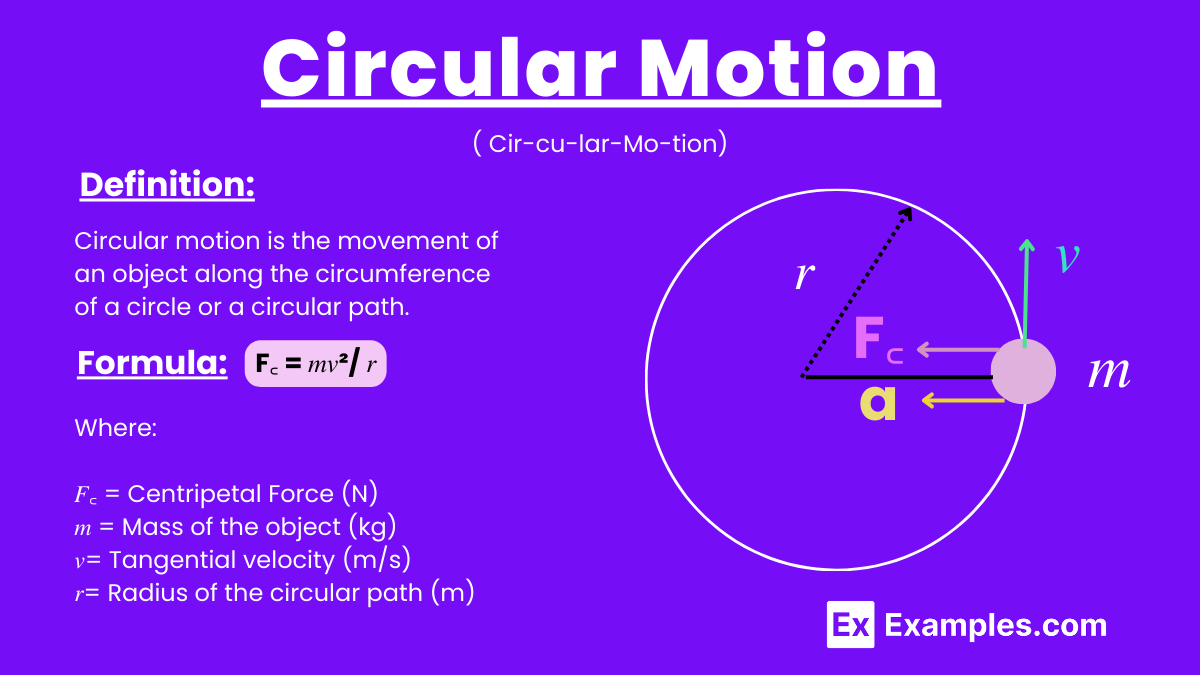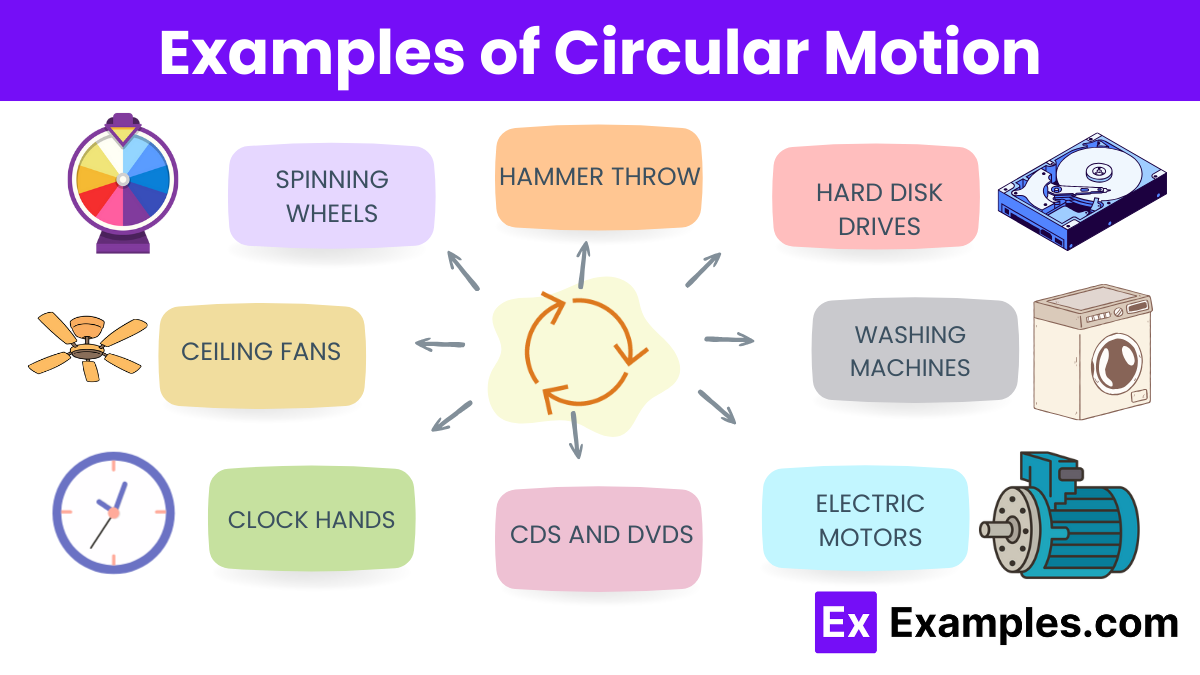What is the centripetal force in circular motion?
The force that acts outward from the center of the circle
The force that acts tangent to the circle
The force that acts towards the center of the circle
The force that opposes gravity


Circular motion refers to the movement of an object along the circumference of a circle or a circular path. In this type of motion, the object’s distance from a fixed central point remains constant while it travels around this point. The velocity of the object changes direction continuously, even if its speed remains constant, due to the centripetal force acting towards the center of the circle. This force is essential to maintain the circular trajectory, counteracting the object’s natural tendency to move in a straight line due to inertia. Circular motion is commonly observed in planetary orbits, the motion of a car around a curved track, and the rotation of a fan blade.
Circular motion is the movement of an object along the circumference of a circle or a circular path. This motion involves a continuous change in direction, leading to centripetal acceleration towards the center of the circle, essential in understanding rotational dynamics.
Where:
𝐹꜀ = Centripetal Force (N)
𝑚 = Mass of the object (kg)
𝑣= Tangential velocity (m/s)
𝑟= Radius of the circular path (m)
Where:
a꜀= Centripetal Acceleration (m/s²)
v = Tangential velocity (m/s)
r = Radius of the circular path (m)
Where:
Where:
Where:
Where:
Understanding these formulas is crucial for analyzing various real-world scenarios involving circular motion, such as:

Circular motion is a fundamental concept in physics, describing the motion of an object along the circumference of a circle. This motion can be categorized based on several criteria. Below are the primary types of circular motion:
| Aspect | Uniform Circular Motion | Non-Uniform Circular Motion |
|---|---|---|
| Speed | Constant | Variable |
| Acceleration | Centripetal acceleration only | Both centripetal and tangential accelerations |
| Velocity | Constant magnitude, changing direction | Changing magnitude and direction |
| Force | Constant magnitude, directed towards the center | Variable magnitude and direction |
| Examples | Earth orbiting the Sun | Car accelerating/decelerating in a circular track |
| Angular Velocity | Constant | Variable |
Circular motion plays a vital role in various natural phenomena and technological advancements. Here are some significant applications:
A car of mass 1,000 kg is traveling at a speed of 20 m/s around a circular track with a radius of 50 meters. Calculate the centripetal force acting on the car.
Solution:
Answer: The centripetal force acting on the car is 8,000 N.
A wheel rotates 360 degrees (or 2𝜋 radians) in 4 seconds. Calculate its angular velocity.
Solution:
Given:
Angular displacement (𝜃) =2π radians
Time (t) = 4 seconds
Formula: ω= θ/ t
Substitute values in above formula
Answer: The angular velocity of the wheel is π/2 rad/s.
Centripetal force is the inward force that keeps an object moving in a circular path, directed towards the circle’s center.
Centripetal force can be caused by gravity, tension, friction, or other forces acting towards the center of the circle.
Centrifugal force is the apparent outward force felt by an object moving in a circular path, due to inertia.
Angular velocity is the rate of change of an object’s angle as it moves along a circular path, usually measured in radians per second.
Centripetal acceleration is given by a꜀ = v²/r
where
v is the linear velocity and
r is the radius of the circle.
Mass directly affects centripetal force, as the force is given by F꜀ = 𝑚𝑣²/ 𝑟
Frequency is the number of revolutions per unit time and is the reciprocal of the period,
Friction provides the necessary centripetal force for circular motion in cases like cars turning on a road.
If the radius is doubled, the centripetal force is halved, assuming constant mass and speed.
Astronauts experience weightlessness because they are in free fall, constantly falling towards Earth but moving forward fast enough to miss it.
Text prompt
Add Tone
10 Examples of Public speaking
20 Examples of Gas lighting
What is the centripetal force in circular motion?
The force that acts outward from the center of the circle
The force that acts tangent to the circle
The force that acts towards the center of the circle
The force that opposes gravity
Which quantity remains constant for an object moving in uniform circular motion?
Velocity
Acceleration
Speed
Force
What is the direction of the acceleration vector in circular motion?
Tangent to the circle
Away from the center
Towards the center
Perpendicular to the plane of the circle
If the radius of a circular path is doubled while keeping the speed constant, what happens to the centripetal force?
It doubles
It halves
It remains the same
It quadruples
What happens to the period of an object in circular motion if the frequency is increased?
The period increases
The period decreases
The period remains the same
The period becomes zero
In circular motion, which force is responsible for keeping the object moving along the curved path?
Gravitational force
Normal force
Frictional force
Centripetal force
If the speed of an object in circular motion is doubled, how does the centripetal force change?
It remains the same
It doubles
It quadruples
It halves
What does the term "angular velocity" refer to in circular motion?
The rate at which an object moves through the circle
The rate at which the angle changes
The speed of the object in the circle
The force acting on the object
Which of the following factors affects the centripetal force?
Mass of the object
Speed of the object
Radius of the circle
All of the above
What would be the effect of increasing the radius of the circular path while keeping the speed constant?
The centripetal force increases
The centripetal force decreases
The centripetal force remains the same
The speed of the object increases
Before you leave, take our quick quiz to enhance your learning!

